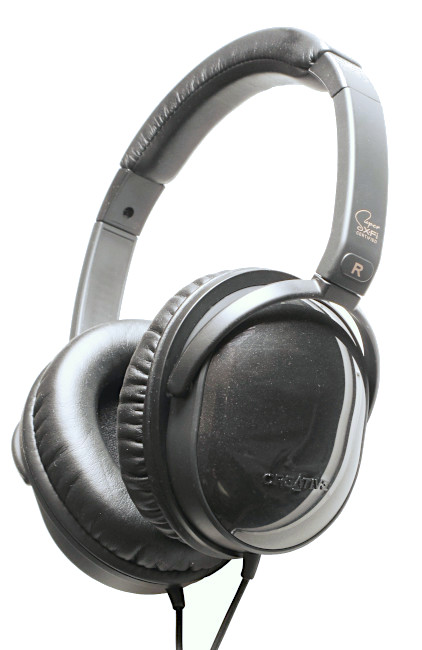Aurvana Live! SE
back to Creative
back to measurements
home
Published: Nov-06-2022
NO SMOOTHING is applied to the shown plots. Most measurement sites have some smoothing applied which ‘irons flat’ sharp peaks and ‘wiggles’. I do not use smoothing because some info about sound quality is lost when plots are smoothed.
Aside from a small correction of the microphone itself also some correction in the lowest frequencies is applied to the plots to compensate for the perceived loss of bass when using headphones. This is described HERE in more detail.
A ‘horizontal‘ frequency response curve on the shown frequency response plots on this website thus indicates a perceived ‘flat’ tonal signature.
ALL measurements are made with a good SEAL on a flatbed measurement rig.
The shape of your head, bone structure, pad size, pad ‘softness, (compliance), hair or no hair and or wearing glasses may (drastically) change the frequency response of some headphones, so… your personal experience may differ substantially from these plots.
Frequency response (tonal balance) is the most sound-determining aspect of headphones. A horizontal line shows audible neutral response in the plots on this website. Deviations in different severity at different frequency bands have an effect on the sound character.
The bigger the deviation the stronger the effect.
Below an aid to help determining the sound character of headphones with relation to the frequency response.

Creative Aurvana Live! SE
The Creative Aurvana Live! SE is slightly better tuned version of the Creative Aurvana Live! which was basically a Denon D1001. The drivers used in these 3 headphones are exactly the same type (Foster 399317).
These were made by Foster and use the well known Foster bio-cellulose 40mm drivers. It comes in a black version and has a glossy ‘flake paint’ finish on the cups.
When these came out (around 2019) the MSRP was around $ 100.- but end 2022 it is still being sold for $ 50.- (€ 60 in E.U.).
It is a re-launch of the popular original Creative Aurvana Live! (2011) with a different color scheme.
There is also a slightly more expensive Auvana Live! 2 which is quite different on many fronts and just slightly more expensive and not as good sounding out of the box (much warmer/bassier).
The build quality is a bit cheap plastic feeling but does not appear to be of questionable build quality.
When handled with care I don’t think it will break.
The headphone can not fold flat or collapse and no bag is supplied so when taking it along it may take up more space than more purpose built designs.
The headband can extend 32mm. The cups can tilt and swivel far enough for a comfortable fit on most heads. The headrest pleather covered, is small and has some foam inside but one quickly hits hard plastic edges of the headband.
The pads have firm memory foam inside and are covered with thicker vinyl leather look material that feels soft but can become a bit sticky/sweaty on a summer day. I have seen pictures of the pads with ‘cracked’ pleather. The pads can be replaced so replacing them should be no problem.
Room for the ears is not plenty (54mm height, 38mm width and 20mm depth) and is a bit egg-shaped but enough for younger to middle aged folks.
The Aurvana Live! SE has a thin and ‘springy’ silicone-feel split 1.2m cable (dual entry) which is fixed and thus cannot be replaced or be used on balanced outputs is terminated in a straight gold plated 3.5mm TRS plug.
No 6.3mm adapter is supplied. The short cable and only a 3.5mm TRS plug suggests this headphone is intended for desktop and portable usage. There is no mic/remote (the Aurvana Live! 2 does have this) so the usage is limited to listening only.
The cable is somewhat microphonic. This means touching the cable and it rubbing against clothes is audible in the left cup when no music is playing.
The sensitivity is quite high (120dB/V @ 1kHz) so it can play impressively loud even from portable sources like phones etc. Even with EU phones with output power restrictions it can play loud.
This headphone is lightweight (210 with the cable) and combined with the medium clamping force (3.5N) makes it a comfortable headphone.
This headphone is for sale.
specifications:
Type: Over-ear, closed
Usage: Home, Portable
Isolation: decent
Driver type: dynamic, bio-cellulose
Pads: replaceable, pleather with memory foam
Inner pad dimensions: Height: 54mm, width: 38 mm, depth: 20mm, egg shaped
Collapsible: no
Headphone connector: fixed, dual entry
Cable: 1.2m terminated in straight gold plated 3.5mm TRS plug
Driver size: ø 40mm
Max. power rating: 1.3W
Max. voltage: 6.2V
Max. current: 190mA
Max. S.P.L.: 130dB
Impedance: 30Ω (measured)
Sensitivity: 120dB @ 1V
Efficiency: 105dB @ 1mW
Weight: 205 g.
Color: black
Clamping force: medium-low (3.5N)
Accessories: none
Sound description:
This headphone has tastefully elevated bass which is a bit ‘woolly’, which means lacking in tightness and clear definition in the lows.
Mids are present and on the warm side of neutral.
Treble is present and not sharp nor does it sound rolled-off but it is a bit accentuated.
Stereo imaging is similarly ‘narrow’ as the HD650 (not the tonal balance, just the stereo ‘width’)
Very pleasant in tonal character. The sound isn’t dynamic because of the somewhat muddy bass and warmth. Some improvements can be had with some reversible and not complicated modifications.
I would say definitely amongst the best sounding closed headphones at the $ 50.- price point.
measurements:
Below the frequency response of the CAL SE (left, right)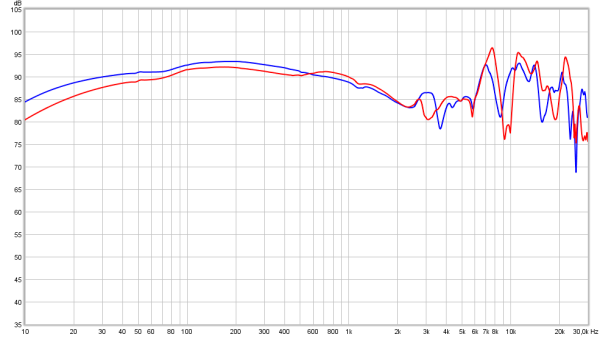
Channel matching is not very good with this particular headphone. Could be better in other copies. More on this aspect further down this page.
There is somewhat of a mid-bass emphasis. Bass extension is excellent down to at least 20Hz (with a perfect seal). The mids have a warm tilt to it (downward slope from 200Hz to 2kHz).
The treble is somewhat elevated but not sharp or sibilant sounding. On some recordings it is bordering on sibilance and sharpness. Treble can have a slight ‘coarse’ sound to it yet on other recordings can have a smooth character.
Below the phase response of the CAL SE (left, right)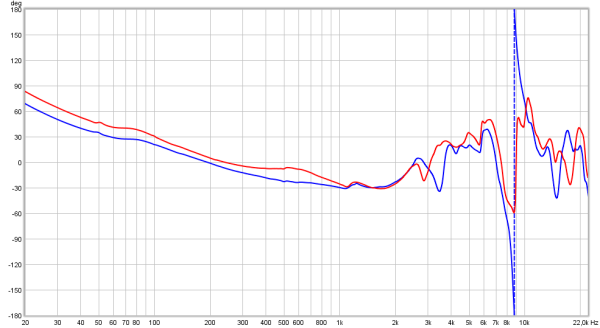
Slow phase shifts are not very audible. Steep changes in a narrow frequency bands may well be audible.
From 6kHz upwards there area few steep changes which might also explain the somewhat lesser treble ‘quality’.
Seal
Seal is quite important for closed headphones and this headphone is no exception. As this is an on-ear glasses etc. do not change the seal but hairs and shape of the pinnae become important factors. Below the effect on the sound is shown when the seal is not perfect. The bass suffers. It is the reason why the current pads are bit bigger and wider and softer so they conform better to the shape of the pinna.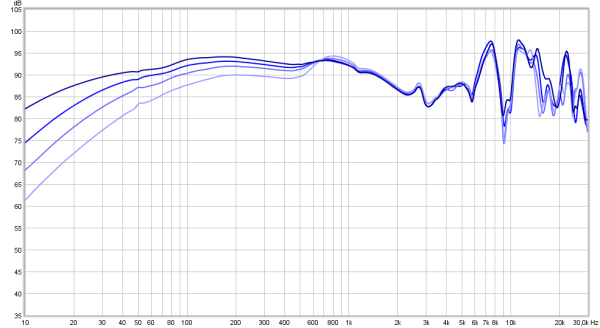
Perfect seal and, in small steps, an increasing amount of leakage right down to seal broken by glasses that are not flush against the skin. Breaking the seal lowers the amount of bass. A small leakage is not very audible but a bit less seal and the bass noticeably suffers.
Comparison
Below the Aurvana Live SE versus the Aurvana Live 2.
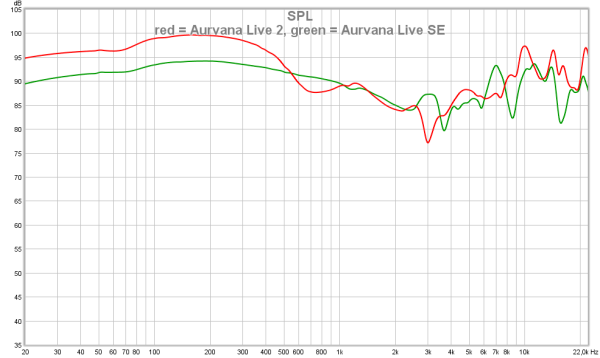 The Aurvana Live 2 has noticeably more bass and warmth.
The Aurvana Live 2 has noticeably more bass and warmth.
Below, alternating, a comparison between Aurvana Live! SE and some other over-ear closed headphones in price classes below and above.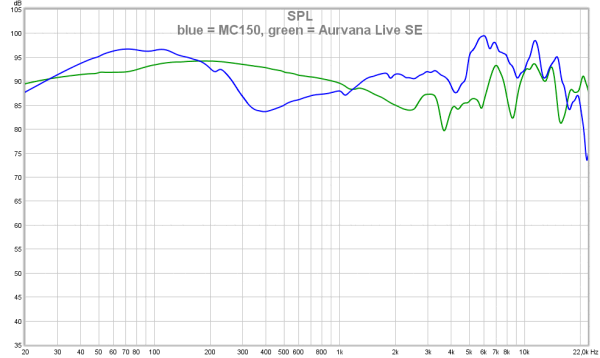
output resistance / damping-factor
As this is a closed dynamic headphone the frequency response can be amplifier output resistance dependent when certain higher output resistance amplifiers are used.
Instead of showing impedance plots, which are hard to ‘read’ when it comes to assessing the tonal balance change in the real world, the Aurvana Live! SE is measured via a few different resistance outputs (0.2Ω, 10Ω, 32Ω and 120Ω). On a higher output resistance amplifier the output level will be lower of course due to voltage division. To compensate for this the amplifier is turned up to the same level (13.7dB for 120Ω at 1kHz in this case at max. volume setting). This way the plots are overlaid and it is easier to see how the tonal balance changes. 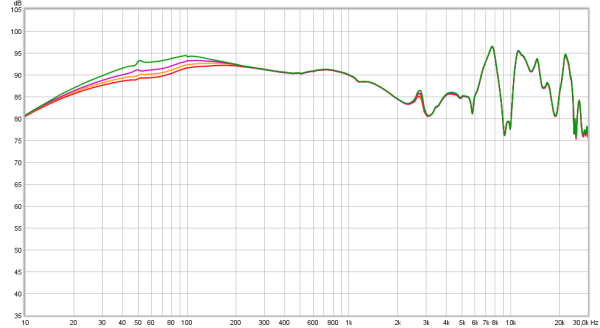 The headphone does not react to higher output resistances. The resonance frequency is a quite low 50Hz. A higher output resistance does have an influence on the tonal balance and adds a bit more bass. Output resistances above 32 ohm (D.F. = 1) is not recommended so less suited for usage with AVR and (older) receivers and integrated amps.
The headphone does not react to higher output resistances. The resonance frequency is a quite low 50Hz. A higher output resistance does have an influence on the tonal balance and adds a bit more bass. Output resistances above 32 ohm (D.F. = 1) is not recommended so less suited for usage with AVR and (older) receivers and integrated amps.
Below the distortion measurements of the Aurvana Live! SE (Right channel) at 90dB SPL.
Below the same distortion plot but with the vertical scale in percentages instead of level differences.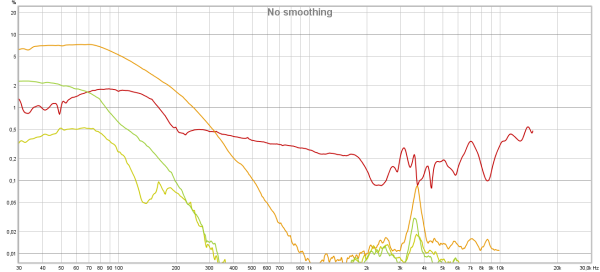 Distortion at 90dB SPL (60 Hz) is quite high (8%) and even worse, it is 3rd and 5th harmonic distortion which is indicative for ‘compression’. Aside from the raised bass levels this kind of distortion is not contributing to good sound reproduction at all. Distortion is quite poor at a bit louder than ‘normal’ listening levels. This, not surprisingly, is equally bad as the CAL-2.
Distortion at 90dB SPL (60 Hz) is quite high (8%) and even worse, it is 3rd and 5th harmonic distortion which is indicative for ‘compression’. Aside from the raised bass levels this kind of distortion is not contributing to good sound reproduction at all. Distortion is quite poor at a bit louder than ‘normal’ listening levels. This, not surprisingly, is equally bad as the CAL-2.
The 2nd harmonic distortion is probably lower than shown as limits of the test rig are around 0.2%.
At 80 dB SPL (1kHz) the distortion is still on the high side and in the bass mostly 3rd harmonic.

At background listening levels (70dB SPL) distortion is low enough. This high level of distortion is caused by under-damping of the driver, see modification section below.
This high level of distortion is caused by under-damping of the driver, see modification section below.
Linearity
To see how severe the compression is the CAL2 is measured 4 times. Once at 70dB, 80dB, 90dB and 97dB SPL (at 1kHz).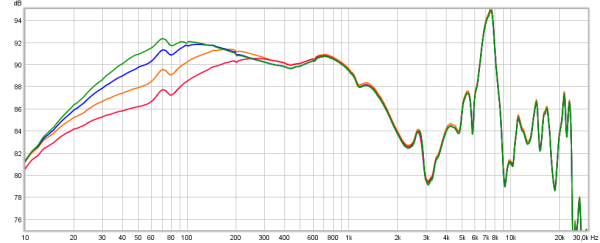 When the traces are overlaid and have the same shape then there is no compression visible. Note the 2dB/div scale. There is compression below 200Hz starting from around 75dB or so.
When the traces are overlaid and have the same shape then there is no compression visible. Note the 2dB/div scale. There is compression below 200Hz starting from around 75dB or so.
This means there is little distortion at comfortable levels but when playing louder the distortion increases quickly. This is audible as the bass sounding a bit muddy and not well defined.
Below the CSD of the Aurvana Live! SE (Left and Right are overlaid).
 At 7.5kHz there are some resonances showing. Also around 3kHz there is some resonance but is short-lived and not very audible.
At 7.5kHz there are some resonances showing. Also around 3kHz there is some resonance but is short-lived and not very audible.
Below the spectrum plot of the Aurvana Live! SE (Right channel). 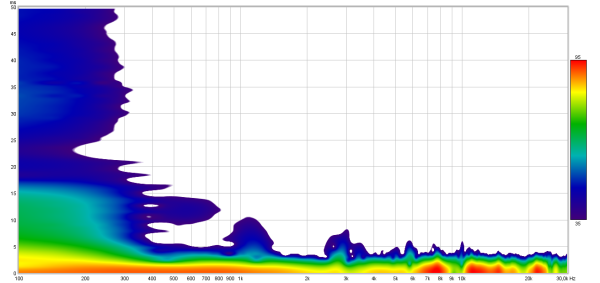 There is some very short lived low level lingering around 1kHz but that is of no importance.
There is some very short lived low level lingering around 1kHz but that is of no importance.
Below the group delay plot of the Aurvana Live! SE (left, right)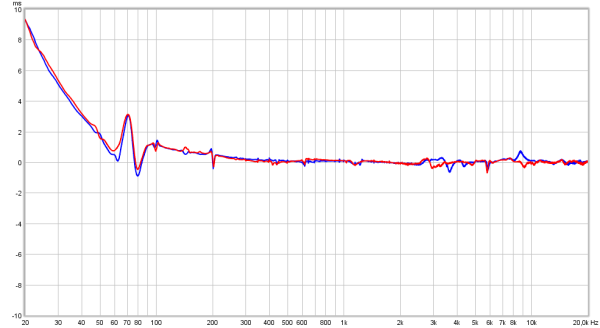
Around 60Hz-90Hz there is some ‘pad bounce’ but this is very small. No major issues here.
The step response of the Aurvana Live! SE (left, right) The initial rise reaches about -5dB. The wide peak at around 1ms is indicative of the emphasis in the bass area. The rising part up to 400μs shows the warm tilt.
The initial rise reaches about -5dB. The wide peak at around 1ms is indicative of the emphasis in the bass area. The rising part up to 400μs shows the warm tilt.
The left and right channel clearly show some channel imbalance in the lows.
The horizontal part of the trace just sags slowly showing the extended sub-bass extension.
modification
The sound of the Aurvana Live! SE is a bit warm and bass is not very defined/tight. Treble is present but a bit elevated.
For the Aurvana Live 2, which has the exact same 199317 type driver, just like the Denon D1001 b.t.w., reacted positively to damping the rear of the driver by sealing holes (in the red and green circles) in the damping paper.
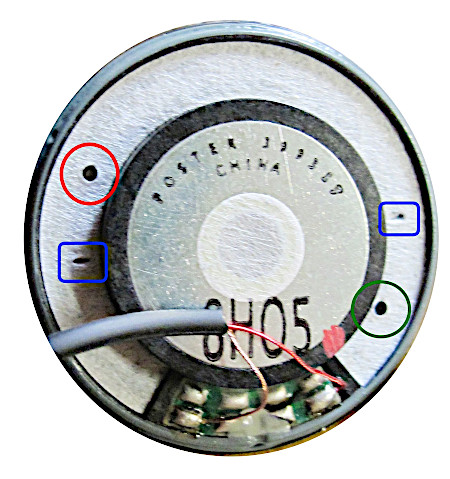
Below the left driver in stock form, with 1 hole closed and with both holes closed.
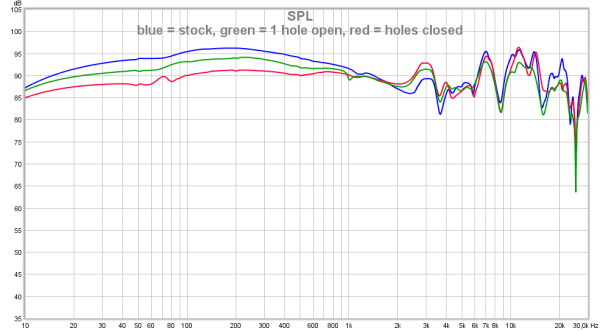 With both holes closed the distortion was reduced drastically.
With both holes closed the distortion was reduced drastically.
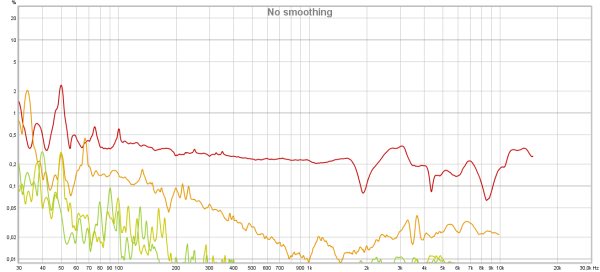 But… the sound became a bit weird/harsh in the mids (I blame the 3kHz peak) and way too trebly with poor treble quality. Besides the right channel had way too little bass once both holes and the ‘tuning holes’ were closed.
But… the sound became a bit weird/harsh in the mids (I blame the 3kHz peak) and way too trebly with poor treble quality. Besides the right channel had way too little bass once both holes and the ‘tuning holes’ were closed.
To perform this modification the pads have to be removed and the 2 Philips head screws have to be removed. The baffle (with driver) can be taken out. Do this carefully as the driver is connected with thin wires. Sealing the hole(s) can be done using small pieces of tape large enough to cover the small holes.
channel imbalance issue
I had contacted Creative support about the production tolerances for the driver specs and asked if both drivers are within tolerance. Their answer was:
The results received from the headset that you have tested fall within product tolerances.
The right driver had less bass and more treble than the left driver. I think the left driver is representative for how the headphone should sound. Obviously the lesser amount of bass was noticed in the factory and they decided to make a few more small holes (blue rectangles) to tune the amount of lows. Unfortunately it still wasn’t correct and on top of that the same driver also had much more reble.
After some experimenting with closing holes the best result was achieved by sealing one hole (the one in the red circle) on the left driver and sealing the ‘extra’ holes in the right driver.
Reducing the bass area meant the treble was now relatively even more elevated.
Some experimenting with toilet paper in front of the Aurvana Live 2 (results below) prompted me to use the same treble reduction method.
 As the left driver only needed a little treble reduction but the right driver quite a bit more.
As the left driver only needed a little treble reduction but the right driver quite a bit more.
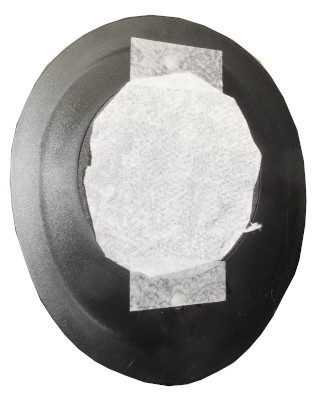 In the end the modifications for this particular headphone ended up being:
In the end the modifications for this particular headphone ended up being:
Left driver: 1 hole closed (simply taped off) and 1 ply (of a 3-ply sheet) toilet paper in front of the driver.
Right driver: only the ‘extra holes’ closed and both original holes open and 2 plies (of 3-ply) toilet paper in front of the driver.
This resulted in the frequency response below.
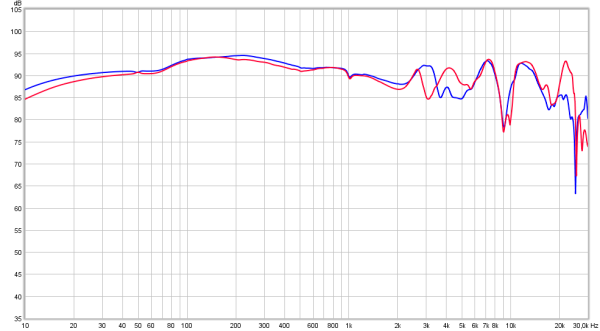 Pretty decent channel matching. Still somewhat warm mids and bass is still a bit ‘woolly’ but not as much. Clarity improved and the treble is smoother and not elevated any more.
Pretty decent channel matching. Still somewhat warm mids and bass is still a bit ‘woolly’ but not as much. Clarity improved and the treble is smoother and not elevated any more.
This has become a very enjoyable headphone.
Below the step response which is also improved.
 Distortion remained pretty much the same but as long as one does not play this headphone at loud levels it sounds very good, certainly for its price.
Distortion remained pretty much the same but as long as one does not play this headphone at loud levels it sounds very good, certainly for its price.
Below the CSD of the modified Aurvana Live-SE. This also improved and certainly the treble response is much better now.
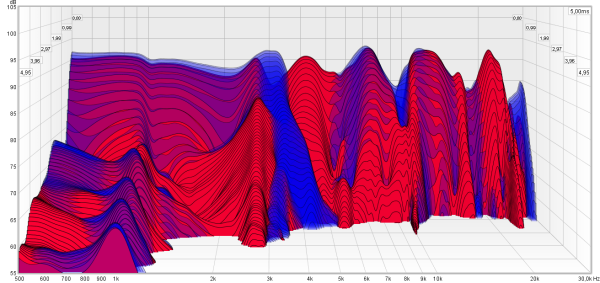 Most likely, any Aurvana Live SE that has one hole shut and 1 ply of toilet paper between the driver and the pad will be enough to lower the warmth a bit as well as the treble.
Most likely, any Aurvana Live SE that has one hole shut and 1 ply of toilet paper between the driver and the pad will be enough to lower the warmth a bit as well as the treble.
summary
The Creative Aurvana Live! SE is a closed over-ear headphone with a contemporary look.
It sound quite pleasant as is, a bit ‘woolly’ in the bass and a tad on the warm side with present treble that is a tad emphasized.
With some simple modifications (which require opening the headphone) the sound can be improved a little.
This headphone is quite sensitive so can play loud, even from a phone. The microphone, one button remote and in-line volume control and it being a closed headphone makes it quite suited for portable duties on a phone, tablet or laptop.
It is reasonably well made. The cable is not removable and a bit thin and ‘springy’. The pads can easily be replaced. The headphone is not heavy in weight.
Comfort wise this headphone is decent. The room in the pads is kind of small but good enough for most people below 40 y.o. The pads do get a bit sweaty/sticky on warmer days and the headband padding is a bit thin.
Prices are usually somewhere between $ 50.- and $ 70.-
In short: a cheap headphone with decent build quality and very pleasant sound signature.

